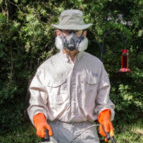A Few Notes on Insecticide Use

Recently, I was reviewing my notes of Jim Roberts (See Note 1) 2012 presentation to the Jacksonville Orchid Society on “Growing Orchids Outside.” During that presentation, Jim made a little noted comment about application of insecticide.
He said: “Read the Instructions.”
This is really a very important observation. Reading instructions as we all have seen, tell us about the amount of insecticide to use in a given application. However, most of us stop at that point. We shouldn’t; we really need to read all of the instructions and the warnings as well.
Many will say they get it, but then go right ahead and apply insecticides with little concern about their exposure after the first time they get some on themselves and nothing happens. The truth, however, is a bit more complicated.
But first a little background. Many of you know that I retired after a career in the Army. I spent most of my time as a Chemical Officer; that is to say, an expert in the use of chemical, as well as biological and nuclear weapons. Moreover, my last job before joining the Army was as an exterminator applying chemical insecticides. No doubt, many will say: ok, I get the connection, but most don’t. The important thing to know is that the “nerve agent” (See Note 2) series of chemical weapons are simply insecticides for bigger bugs – People!
Many of the more effective insecticides belong to a class of chemicals known as organophosphate compounds and were first discovered shortly before World War II by German chemists looking for better insecticides. The good news for us as insecticide users is that the ones we use are far weaker than those used as nerve agents. But here’s the problem, they are still dangerous. Many of these compounds act as a cumulative poison. A little bit today won’t hurt, but who knows about tomorrow? Moreover, the medical research is still not complete about sub-critical dosages and their effects on human health.
Ever notice a statement on some insecticides that “atropine is antidotal?” Atropine is the first of several antidotes administered to counter-act the effects of nerve agent poisoning!
So what to do? I’m not a “licensed professional,” but like everyone else, do use insecticides. Here’s my method, use it if you will, without warranty. My approach is intended to minimize my exposure:
- Wear a charcoal-based respirator (charcoal-filled)
- Wear clothing that leaves little to no exposed skin
- Wear a hat
- Wear wrap-around eye protection.
- Wear chemical proof gloves
- Apply insecticide with the wind behind you so that it blows any excess away from you
- Don’t apply around gardens or other food stuffs
- Don’t allow the overspray to hit gardens, foodstuffs, others, children, or pets.
- Immediately upon finishing, wash your hands and exposed skin with cold water (which lessens likelihood of absorption)
- Immediately upon finishing, separately wash your clothes and exposed articles.
- Use only one sprayer for insecticides, don’t use it for anything else (You don’t want to spray high-strength insecticides on your garden by mistake!).
- Rinse-out your sprayer after use to minimize exposure later.
This seems like a lot to go through just to use insecticide. There is. Having been in the business of killing little bugs and knowing how to defend against those trying to kill us bigger bugs, I choose to err on the side of caution.
Note 1 – Roberts, J. (2012, April 10). Growing Orchids Outside. Presentation to the Jacksonville Orchid Society. Jacksonville, Fl. Jim Roberts is the owner of Florida Sun Coast Orchids; http://floridasuncoastorchids.com.
Note 2 – The Wikipedia article on nerve agents is pretty good if you’d like to learn more. See https://en.wikipedia.org/wiki/Nerve_agent.
– Art Russell
http://orchid-mans-son.com




